Spatial Coherency Model Considering Focal Mechanism Based on Simulated Ground Motions
Abstract
:1. Introduction
2. Deterministic Physics-Based Simulation of Ground Motions
3. Estimation of Coherency of Simulated Ground Motion
4. Effect of Focal Mechanism on Coherency of Simulated Ground Motions
5. Focal Mechanism Dependent Coherency Model
6. Conclusions and Discussion
- (1)
- The coherency of simulated ground motions shows a decreasing trend with the increasing distance and frequency, indicating the reliability of the deterministic physics-based simulations;
- (2)
- For the parallel-to-fault site pair, more loss of coherency will be found, which is also observed in [30]. In addition, for the parallel fault component, the coherency of the dip-slip fault decays faster than that of the strike-slip fault; however, for perpendicular fault components, the strike-slip fault provides lower coherency. For the perpendicular-to-fault site pair, the larger the dip, the less loss of coherency;
- (3)
- The statistical analysis of the parameters, a and b, in the Loh coherency model, shows that a normal distribution is assigned to a, whereas b follows the beta distribution. The distribution parameters could be utilized to generate a and b for any unknown focal mechanism;
- (4)
- A focal-mechanism-dependent coherency model was proposed, based on the Loh coherency model. In terms of the comparison of coherency models, simulation-based models generally provide higher predicted coherencies than record-based models, except for the Ding 2020 model.
Author Contributions
Funding
Informed Consent Statement
Acknowledgments
Conflicts of Interest
References
- Wang, J.; Wang, Q.X.; Jiang, J.R. Response of long-span arch bridge under spatially varying ground-motion. J. Vib. Eng. 1995, 2, 1004–4523. [Google Scholar]
- Yang, Q.S.; Liu, W.H.; Tian, Y.J. Response analysis of national stadium under spatially variable earthquake ground-motion. China Civ. Eng. J. 2008, 2, 35–41. [Google Scholar]
- Zhao, D.H.; Shen, P.J.; Liu, G.H. Dynamic elastic-plasticity analysis of long-span exhibition hall under multi-support seismic excitations. J. Harbin Inst. Technol. 2016, 48, 70–74. [Google Scholar]
- Wu, Z.J. Generation of Spatial Correlation Ground-Motion and the Study of Inconsistency Motivation about Underground Pipeline; Southwest Jiaotong University: Chengdu, China, 2012. [Google Scholar]
- Yuan, M.Z. Seismic Response of Underground Structure under Non-Uniform Seismic Excitation; Wuhan University of Technology: Wuhan, China, 2019. [Google Scholar]
- Kiureghian, A.D. A coherency model for spatially varying ground-motion. Earthq. Eng. Struct. Dyn. 1996, 25, 99–111. [Google Scholar] [CrossRef]
- Harichandran, R.S. Spatial Variation of Earthquake Ground Motion, What Is it, How Do We Model It, and What Are Its Engineering Implications? Department of Civil and Enviromental Engineering, Michigan State University: East Lansing, MI, USA, 1999. [Google Scholar]
- Soyluk, K.; Dumanoglu, A.A. Spatial variability effects of ground-motion on cable-stayed bridges. Soil Dyn. Earthq. Eng. 2004, 24, 241–250. [Google Scholar] [CrossRef]
- Soyluk, K. Comparison of random vibration methods for multi-support seismic excitation analysis of long-span bridges. Eng. Struct. 2004, 26, 1573–1583. [Google Scholar] [CrossRef]
- Wang, Y.L. Parameter Analysis of Seismic Spatial Correlation Effects on Single-Layer Reticulated Domes; Harbin Institute of Technology: Harbin, China, 2013. [Google Scholar]
- Harichandran, R.S.; Vanmarcke, E.H. Stochastic variation of earthquake ground-motion in space and time. J. Eng. Mech. 1986, 112, 154–174. [Google Scholar] [CrossRef]
- Harichandran, R.S. Local spatial variation of earthquake ground-motion. In Earthquake Engineering and Soil Dynamics II—Recent Advances in Ground-Motion Evaluation; American Society of Civil Engineers: New York, NY, USA, 1988; pp. 203–217. [Google Scholar]
- Loh, C.H.; Yeh, Y.T. Spatial variation and stochastic modelling of seismic differential ground movement. Earthq. Eng. Struct. Dyn. 1988, 16, 583–596. [Google Scholar] [CrossRef]
- Loh, C.H.; Lin, S.G. Directionality and simulation in spatial variation of seismic waves. Eng. Struct. 1990, 12, 134–143. [Google Scholar] [CrossRef]
- Abrahamson, N.A.; Schneider, J.F.; Stepp, J.C. Empirical spatial coherency functions for application to soil-structure interaction analyses. Earthq. Spectra 1991, 7, 1–27. [Google Scholar] [CrossRef]
- Hao, H.; Oliveira, C.S.; Penzien, J. Multiple-station ground motion processing and simulation based on SMART-1 array data. Uclear Eng. Des. 1989, 111, 293–310. [Google Scholar] [CrossRef]
- Menke, W.; Lerner-Lam, A.L.; Dubendorff, B.; Pacheco, J. Polarization and coherency of 5 to 30 Hz seismic wave fields at a hard-rock site and their relevance to velocity heterogeneities in the crust. Bull. Seismol. Soc. Am. 1990, 80, 430–449. [Google Scholar] [CrossRef]
- Chen, Q.J.; Yang, Y.S.; Wang, Y.C. A practical spatial coherency model of seismic ground-motion based on strong earthquake array record. China Civ. Eng. J. 2016, 49, 1–6. [Google Scholar]
- Somerville, P.G.; McLaren, J.P.; Saikia, C.K.; Helmberger, D.V. Site-specific estimation of spatial incoherence of strong ground-motion. Geotech. Spec. Publ. 1988, 20, 188–202. [Google Scholar]
- Somerville, P.G.; McLaren, J.P.; Sen, M.K.; Helmberger, D.V. The influence of site conditions on the spatial incoherency of ground-motion. Struct. Saf. 1991, 10, 1–13. [Google Scholar] [CrossRef]
- Luco, J.E.; Wong, H. Response of a rigid foundation to a spatially random ground-motion. Earthq. Eng. Struct. Dyn. 1986, 14, 891–908. [Google Scholar] [CrossRef]
- Ding, H.P.; Liu, Q.F.; Jin, X.; Yuan, Y.F. A coherency model of ground-motion on base-rock corresponding to dip-slip fault. Earthq. Eng. Eng. Vib. 2003, 2, 8–11. [Google Scholar]
- Ding, H.P.; Liu, Q.F.; Jin, X.; Yuan, Y.F. A coherency function model of ground-motion at base-rock corresponding to strike-slip fault. ACTA Seismol. Sin. 2004, 1, 62–67. [Google Scholar] [CrossRef]
- Yang, Q.S.; Chen, Y.J. A practical coherency model for spatially varying ground-motion. Struct. Eng. Mech. 2000, 9, 141–152. [Google Scholar] [CrossRef]
- Liu, X.M.; Ye, J.H.; Li, A.Q. Space coherency function model of vertical ground-motion. Eng. Mech. 2004, 2, 140–144. [Google Scholar]
- Li, Y.M.; Wu, Z.Q.; Chen, H.G. Analysis and modeling for characteristics of spatially varying ground-motion. J. Vib. Shock 2013, 2, 164–170. [Google Scholar]
- Lu, J.B. Spatial Correlation of Simulated Near-Fault Ground-Motion Field; Institute of Engineering Mechanics: Harbin, China, 2008. [Google Scholar]
- Todorovska, M.I.; Trifunac, M.D.; Ding, H.P.; Orbović, N. Coherency of dispersed synthetic earthquake ground-motion at small separation distances: Dependence on site conditions. Soil Dyn. Earthq. Eng. 2015, 79, 253–264. [Google Scholar] [CrossRef]
- Gatti, F.; Paludo, L.D.C.; Svay, A.; Cottereau, R.; Clouteau, D. Investigation of the earthquake ground-motion coherency in heterogeneous non-linear soil deposits. Procedia Eng. 2017, 199, 2354–2359. [Google Scholar] [CrossRef]
- Zheng, F.; Ye, J.H. Coherency of spatial ground-motion field. J. Vib. Shock 2009, 28, 23–28+192–193. [Google Scholar]
- Hartzell, S.; Harmsen, S.; Frankel, A.; Larsen, S. Calculation of broadband time histories of ground-motion: Comparison of methods and validation using strong-ground-motion from the 1994 Northridge earthquake. Bull. Seismol. Soc. Am. 1999, 89, 1484–1504. [Google Scholar]
- Hartzell, S.; Guatteri, M.; Mai, P.M.; Liu, P.C.; Fisk, M. Calculation of broadband time histories of ground-motion, Part II: Kinematic and dynamic modeling using theoretical Green’s functions and comparison with the 1994 Northridge earthquake. Bull. Seismol. Soc. Am. 2005, 95, 614–645. [Google Scholar] [CrossRef]
- Brune, J.N. Tectonic stress and the spectra of seismic shear waves from earthquakes. Geophys. Res. 1970, 75, 4997–5009. [Google Scholar] [CrossRef] [Green Version]
- Brune, J.N. Correction to tectonic stress and the spectra of seismic shear waves from earthquakes. Geophys. Res. 1971, 76, 5002. [Google Scholar]
- Irikura, K.; Kamae, K. Estimation of strong ground-motion in broad-frequency band based on a seismic source scaling model and an empirical green’s function technique. Ann. Geophys. 1994, 37, 1721–1743. [Google Scholar] [CrossRef]
- Frankel, A. Mechanisms of seismic attenuation in the crust: Scattering and anelasticity in New York State, South Africa, and southern California. J. Geophys. Res. 1991, 96, 6269–6289. [Google Scholar] [CrossRef]
- Frankel, A. Simulating strong motions of large earthquakes using recordings of small earthquakes: The Loma Prieta mainshock as a test case. Bull. Seismol. Soc. Am. 1995, 85, 1144–1160. [Google Scholar] [CrossRef]
- Campillo, M.; Paul, A. Influence of the lower crustal structure on the early coda of regional seismograms. J. Geophys. Res. Solid Earth 1992, 97, 3405–3416. [Google Scholar] [CrossRef]
- Liu, P.C.; Archuleta, R.J.; Hartzell, S.H. Prediction of broadband ground-motion time histories: Hybrid low/high-frequency method with correlated random source parameters. Bull. Seismol. Soc. Am. 2006, 96, 2118–2130. [Google Scholar] [CrossRef] [Green Version]
- Zhu, L.; Rivera, L.A. A note on the dynamic and static displacements from a point source in multilayered media. Geophys. J. Int. 2002, 148, 619–627. [Google Scholar] [CrossRef]
- Finn, W.D.L.; Lee, K.W.; Martin, G.R. Stress Strain Relations for Sand in Simple Shear; Department of Civil Engineering, University of British Columbia: Vancouver, BC, Canada, 1975. [Google Scholar]
- Lee, K.W.; Finn, W.D.L. DESRA-2, Program for the Dynamic Effective Stress Response Analysis of Soil Deposits with Energy Transmitting Boundary including Assessment of Liquefaction Potential; Department of Civil Engineering, University of British Columbia: Vancouver, BC, Canada, 1978. [Google Scholar]
- Abrahamson, N.A.; Schneider, J.F.; Stepp, J.C. Spatial coherency of shear waves from the Lotung, Taiwan large-scale seismic test. Struct. Saf. 1991, 10, 145–162. [Google Scholar] [CrossRef]
- Ding, H.P.; Li, X. Comparison of parametric and non-parametric methods for calculating coherence function. Earthq. Eng. Eng. Dyn. 2020, 40, 11–19. [Google Scholar]
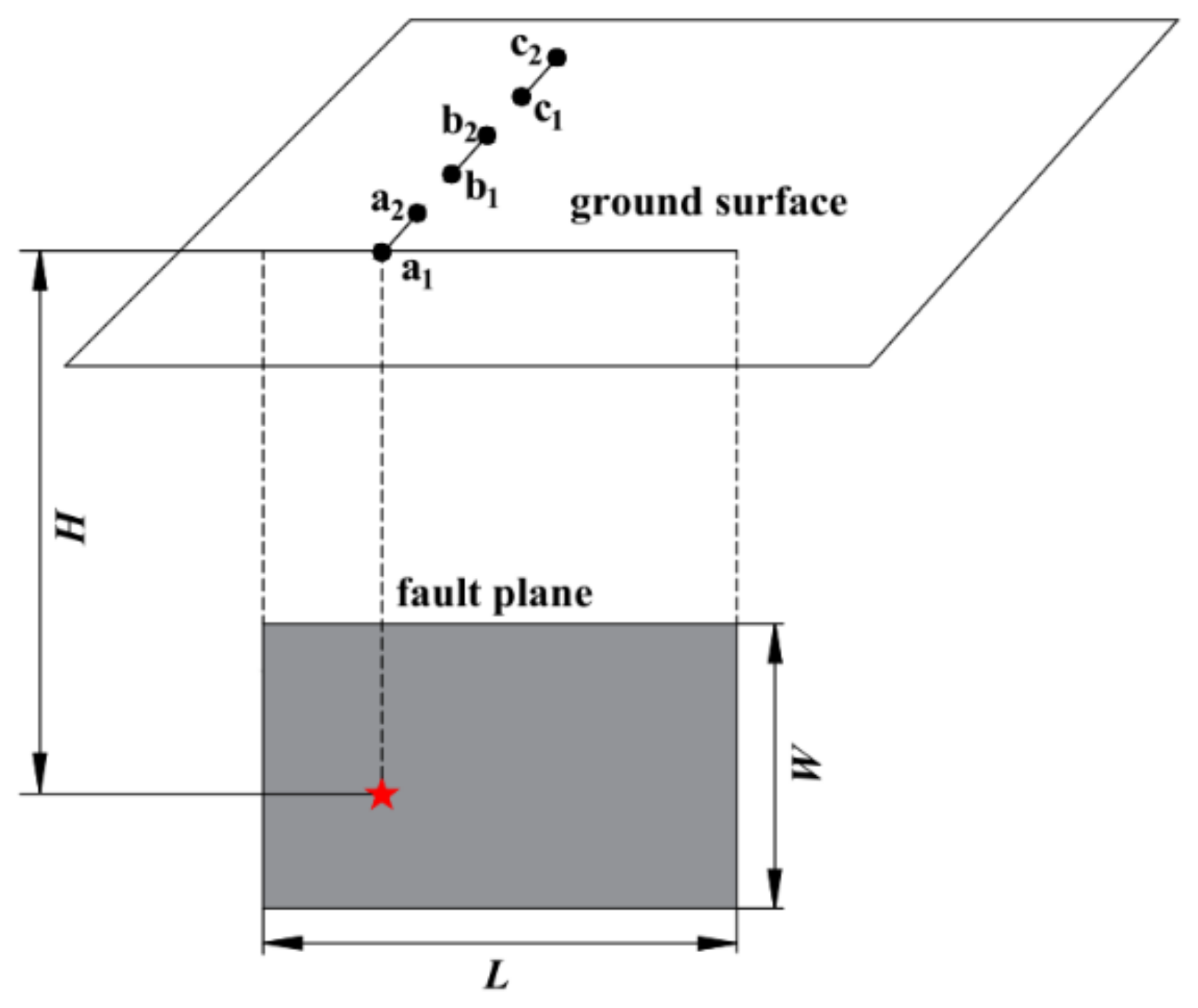

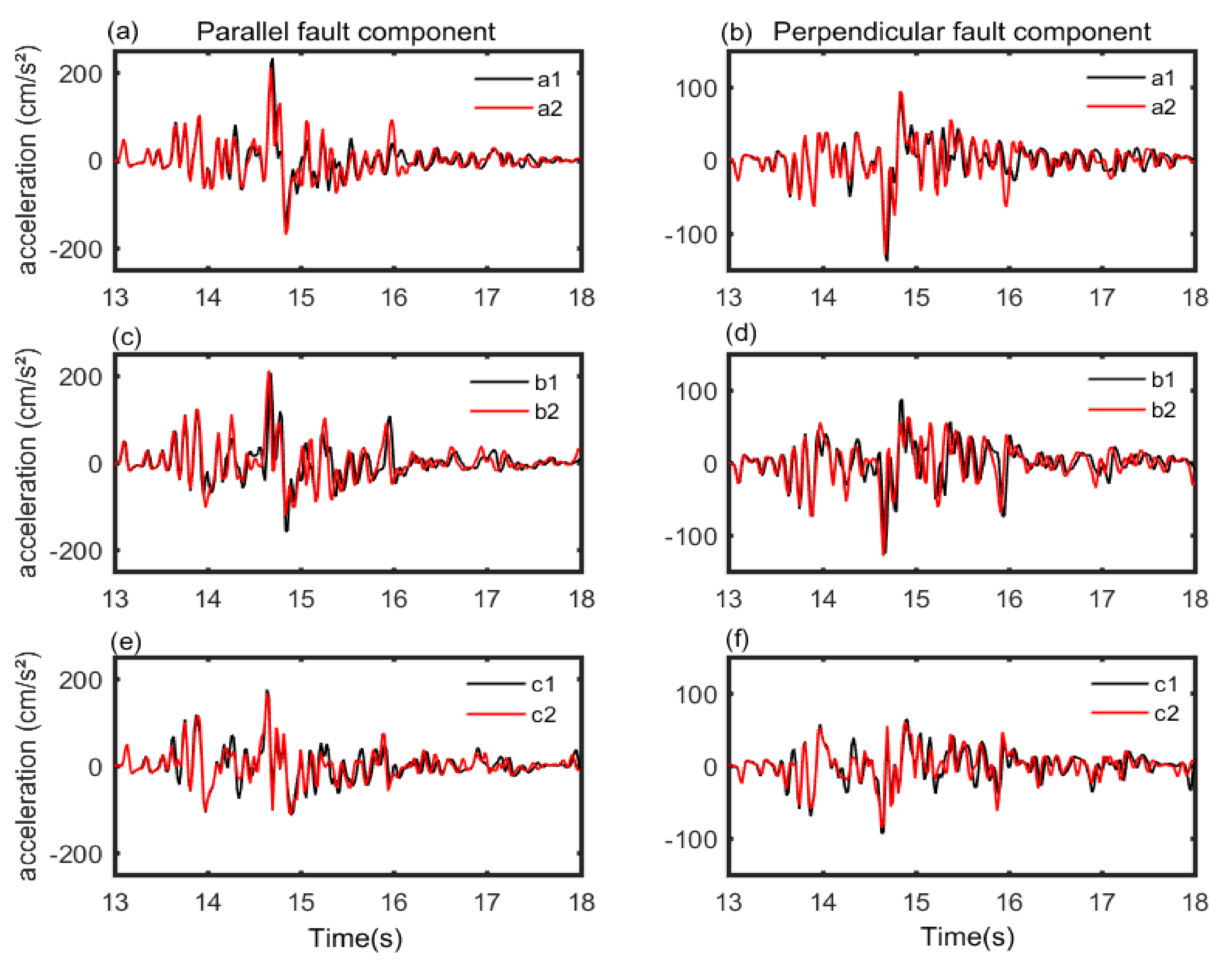



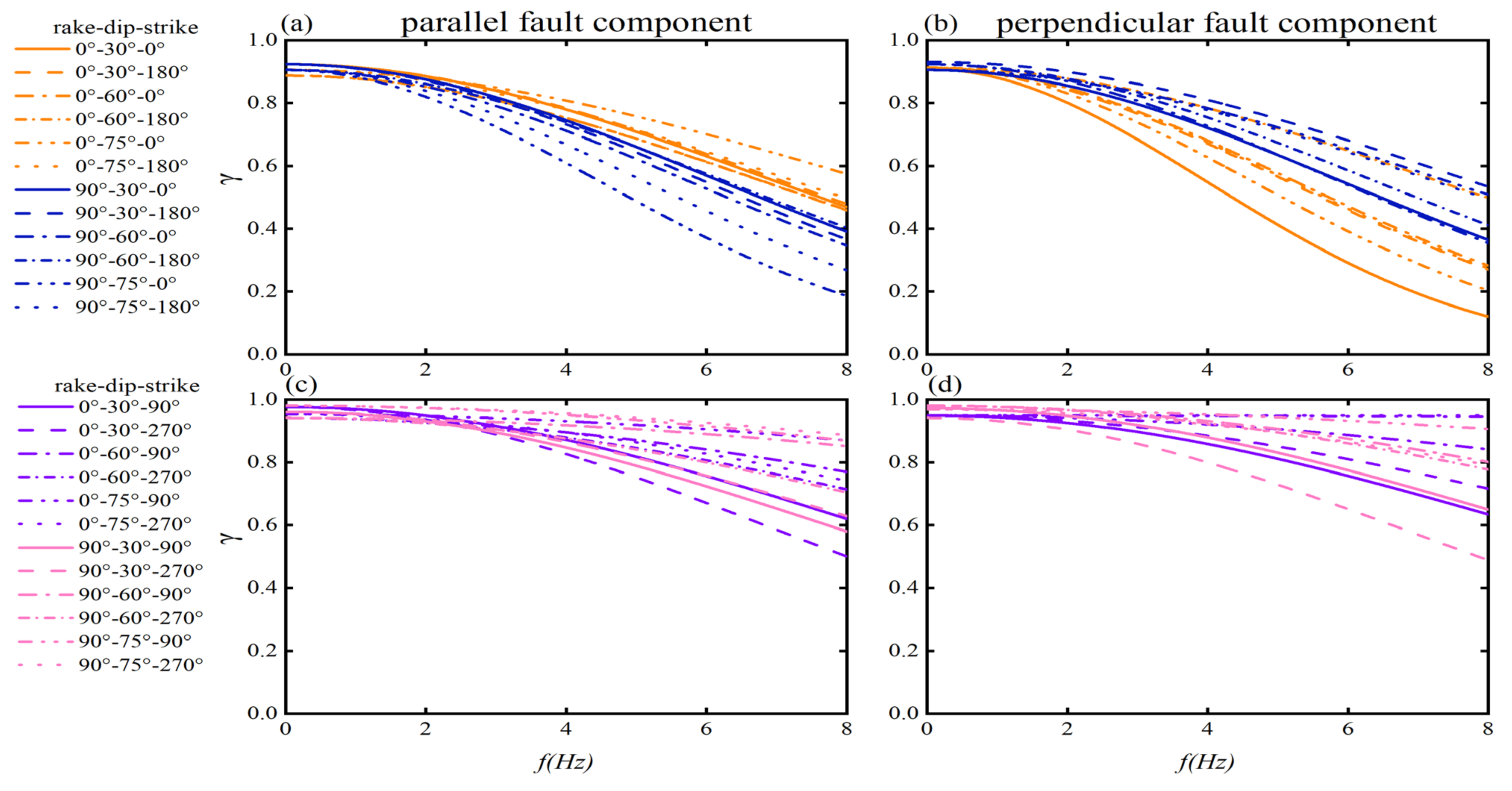
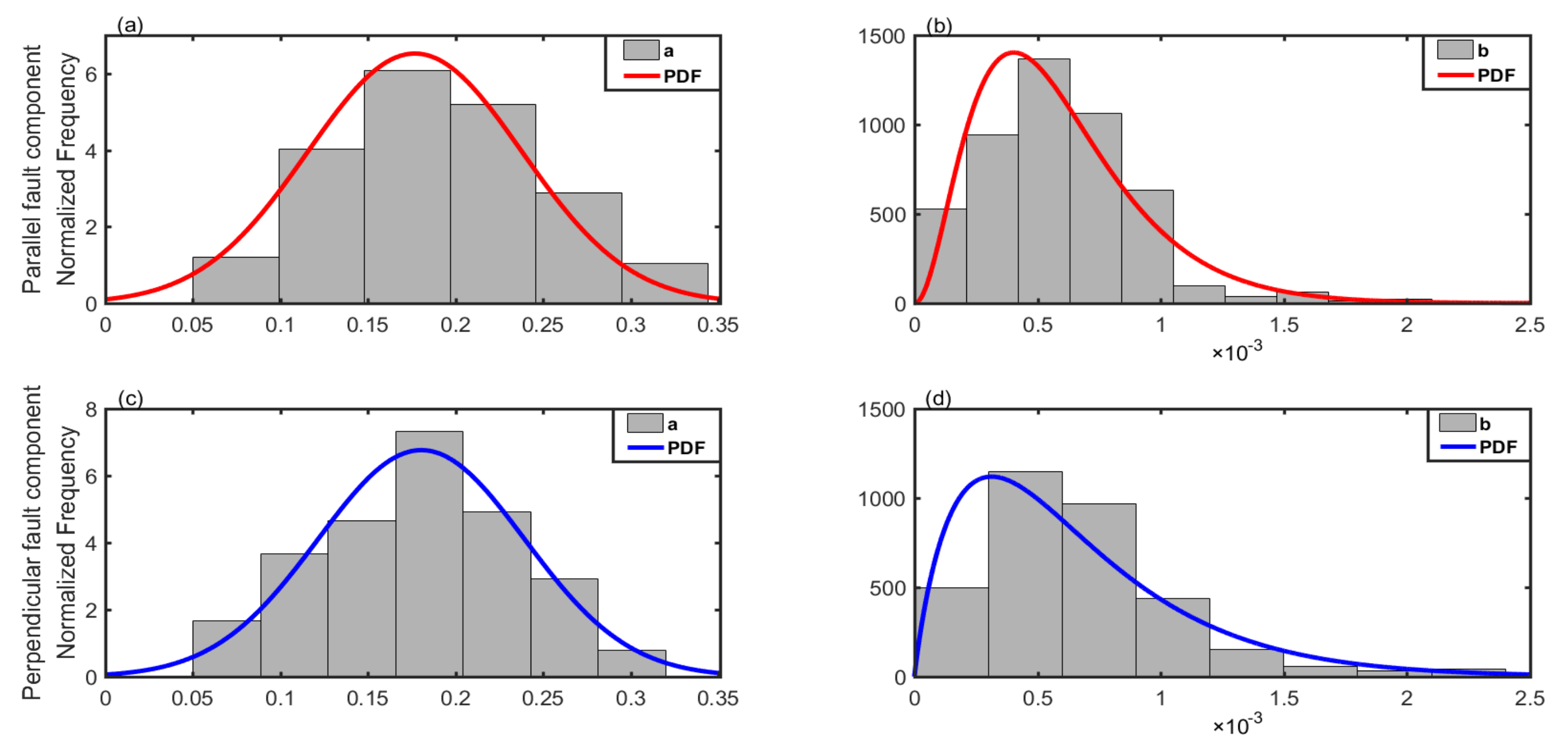



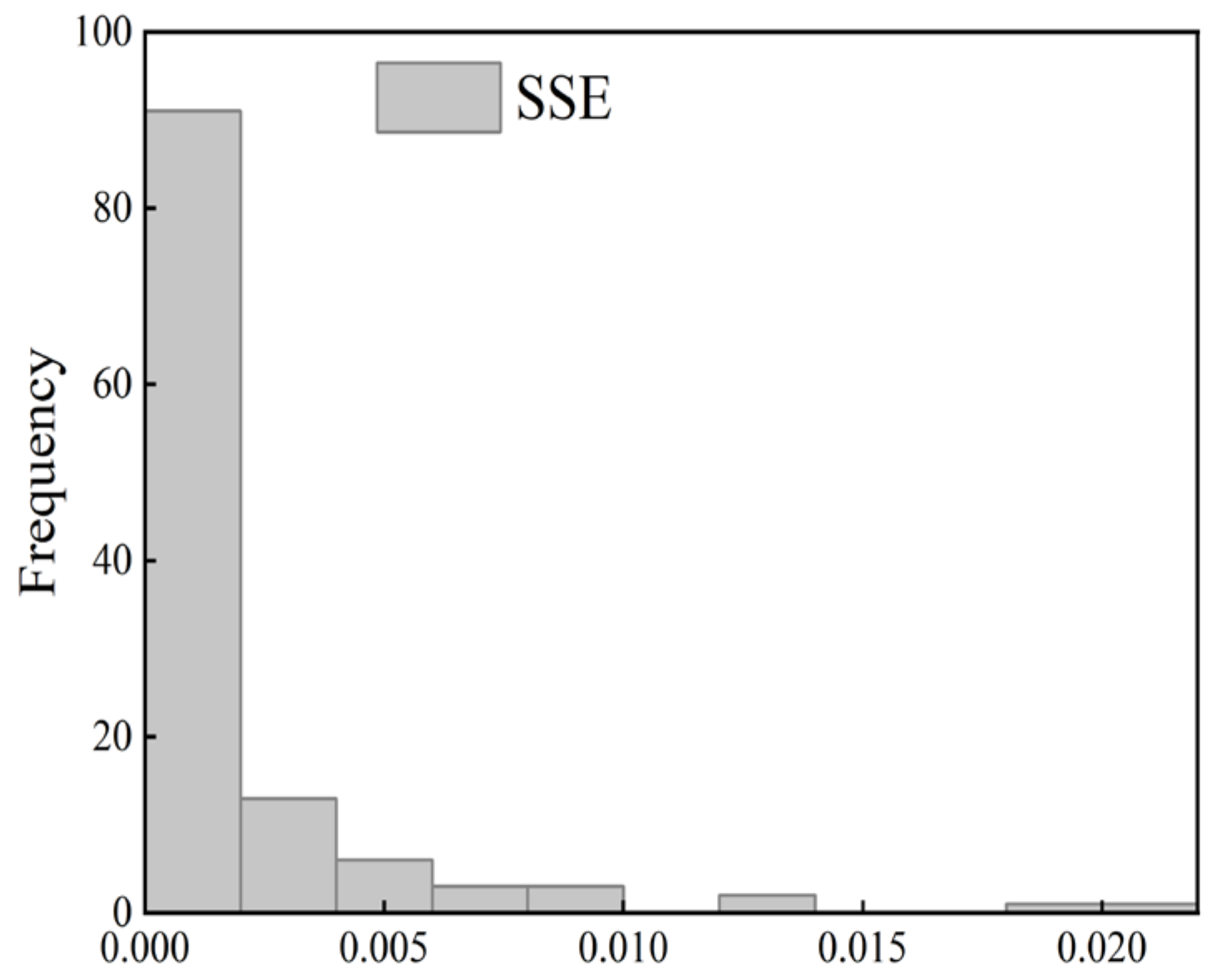

| Horizontal Components of Simulated Ground Motions | |||||
|---|---|---|---|---|---|
| Parallel Fault | Perpendicular Fault | ||||
| Fitted Distribution | Distribution Parameters 1 | Distribution Bounds | Distribution Parameters 1 | Distribution Bounds | |
| a | normal | μ = 0.1768, σ = 0.06117 | (0.05,0.33) | μ = 0.1804, σ = 0.059 | (0.05, 0.3) |
| b | beta | α = 3.16549, β = 5374.2296 | (0.00004,0.002) | α = 1.92026, β = 2937.6033 | (0, 0.0024) |
| Rake (°) | Components of Simulated Ground Motions | P | λ1 | λ2 | λ3 | |
|---|---|---|---|---|---|---|
| 0 | Parallel fault | a | m | 0.0002 | 0.0218 | 0.0903 |
| c | −0.0026 | 0.0199 | 0.2579 | |||
| q | −0.1600 | −1.9400 | 195.0000 | |||
| k | −0.6570 | −0.7500 | 397.0000 | |||
| n | 0.0015 | 0.0284 | 0.0135 | |||
| t | 0.0157 | 0.0000 | 0.7730 | |||
| b | m | 0.0000 | 0.0002 | 0.0002 | ||
| c | 0.0249 | −1.4612 | 0.797 | |||
| q | −0.3390 | −0.2500 | 210.0000 | |||
| k | −0.1470 | 15.1000 | 367.0000 | |||
| n | 0.0000 | −0.0001 | 0.0005 | |||
| t | 0.0093 | 0.0000 | 0.7390 | |||
| Perpendicular fault | a | m | −0.0001 | 0.0062 | 0.0980 | |
| c | 0.0005 | −0.0735 | 0.0768 | |||
| q | −0.0065 | −0.8750 | 181.0000 | |||
| k | 0.0710 | −2.5600 | 366.0000 | |||
| n | 0.0000 | 0.0398 | 0.0982 | |||
| t | 0.0000 | 0.0000 | 1.1700 | |||
| b | m | 0.0000 | 0.0003 | 0.0002 | ||
| c | −0.0106 | −1.3316 | 2.4462 | |||
| q | 0.2080 | 2.5000 | 167.0000 | |||
| k | −0.2060 | 33.4000 | 367.0000 | |||
| n | 0.0000 | −0.0001 | 0.0005 | |||
| t | −0.0005 | 0.0000 | 1.4100 | |||
| 90 | Parallel fault | a | m | 0.0006 | 0.0025 | 0.0745 |
| c | 0.0018 | −0.0039 | 0.0376 | |||
| q | 0.0805 | −2.3800 | 180.0000 | |||
| k | 0.1690 | −2.0000 | 355.0000 | |||
| n | 0.0002 | 0.0579 | 0.0584 | |||
| t | 0.0026 | 0.0000 | 1.2400 | |||
| b | m | 0.0000 | 0.0003 | 0.0001 | ||
| c | 0.0145 | −1.6751 | 1.445 | |||
| q | 0.0521 | 2.3100 | 175.0000 | |||
| k | 0.1970 | 35.6000 | 339.0000 | |||
| n | 0.0000 | 0.0000 | 0.0006 | |||
| t | −0.0018 | 0.0000 | 1.4100 | |||
| Perpendicular fault | a | m | −0.0002 | 0.0419 | 0.1260 | |
| c | 0.0041 | −0.4342 | 0.4244 | |||
| q | −0.2990 | 0.6250 | 205.0000 | |||
| k | 0.0945 | 10.7000 | 358.0000 | |||
| n | 0.0001 | 0.0149 | 0.0527 | |||
| t | 0.0033 | 0.0000 | 0.9050 | |||
| b | m | 0.0000 | 0.0001 | 0.0001 | ||
| c | −0.0126 | −0.2028 | 1.2409 | |||
| q | −0.0973 | −4.3800 | 198.0000 | |||
| k | 0.5210 | 16.2000 | 319.0000 | |||
| n | 0.0000 | 0.0000 | 0.0004 | |||
| t | 0.0064 | 0.0000 | 0.8420 |
Publisher’s Note: MDPI stays neutral with regard to jurisdictional claims in published maps and institutional affiliations. |
© 2022 by the authors. Licensee MDPI, Basel, Switzerland. This article is an open access article distributed under the terms and conditions of the Creative Commons Attribution (CC BY) license (https://creativecommons.org/licenses/by/4.0/).
Share and Cite
Wan, K.; Sun, X.; Liu, Y.; Ren, K.; Sun, X.; Luo, Y. Spatial Coherency Model Considering Focal Mechanism Based on Simulated Ground Motions. Sustainability 2022, 14, 1989. https://doi.org/10.3390/su14041989
Wan K, Sun X, Liu Y, Ren K, Sun X, Luo Y. Spatial Coherency Model Considering Focal Mechanism Based on Simulated Ground Motions. Sustainability. 2022; 14(4):1989. https://doi.org/10.3390/su14041989
Chicago/Turabian StyleWan, Keyu, Xiaodan Sun, Yu Liu, Kang Ren, Xiaoying Sun, and Yanqing Luo. 2022. "Spatial Coherency Model Considering Focal Mechanism Based on Simulated Ground Motions" Sustainability 14, no. 4: 1989. https://doi.org/10.3390/su14041989
APA StyleWan, K., Sun, X., Liu, Y., Ren, K., Sun, X., & Luo, Y. (2022). Spatial Coherency Model Considering Focal Mechanism Based on Simulated Ground Motions. Sustainability, 14(4), 1989. https://doi.org/10.3390/su14041989





